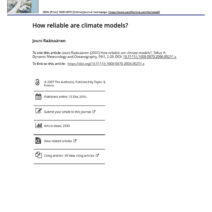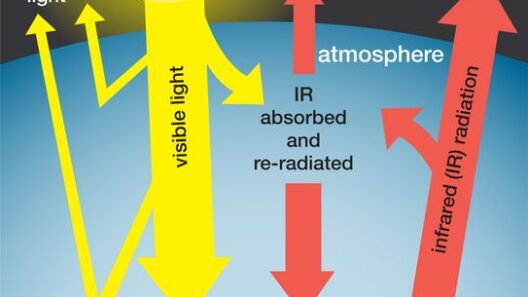In the kaleidoscopic arena of climate debate, Judith Curry embodies the paradox of a scientist dancing on the precipice of skepticism and consensus. Once a staunch advocate for the overwhelming consensus on man-made global warming, Curry has transformed into a contentious figure, encapsulated in layers of complex narratives and divergent viewpoints. Her journey carries the weight of substantial inquiry, raising essential questions about her current stance on climate change.
Curry’s trajectory in the field of climate science is akin to that of a seasoned sailor navigating tumultuous waters. Initially, she was part of the chorus affirming the prevalent scientific consensus, which outlined an unequivocal link between human activity and climate change—a reality evidenced by rising carbon emissions and increasing global temperatures. Yet, as she delved deeper into the nuances of climate modeling and data interpretation, her perspectives began to shift, leading her to challenge established dogmas.
To understand whether Judith Curry still believes in the veracity of global warming, one must dissect her arguments as if peeling an onion—layer by layer revealing underlying complexities. Her skepticism primarily hinges on the uncertainties inherent in climate models. She posits that models often rely on assumptions that can lead to inflated projections of warming. These uncertainties, akin to shadowy figures lurking in fog-laden waters, fuel her skepticism, prompting questions about the solid ground of consensus.
At a foundational level, Curry emphasizes the importance of acknowledging the limitations of predictive models. In a field that predicates its policy recommendations on projections of future conditions, such limitations can be consequential. She suggests that an over-reliance on models may skew public perception and policy decisions, drawing a stark line between caution in climate predictions and alarmism. Thus, the metaphor of a ship steering off course resonantly encapsulates her cautionary stance towards global warming narratives.
However, this skepticism does not equate to outright denial of climate change. Curry still recognizes that anthropogenic factors play a role in influencing the climate system. It is rather a call for a more nuanced conversation—one that balances certainty with doubt. This perspective prompts a broader inquiry into the role of uncertainty in scientific discourse, challenging the scientific community to foster an intellectual environment where dissenting views are examined rather than ostracized.
Curry’s criticism also extends to the scientific community’s approach to communication. She suggests that a binary framing—one that categorizes climate discourse into ‘believers’ and ‘deniers’—can stifle constructive dialogue. The analogy of a pendulum swinging between extremes aptly characterizes this dynamic. In swinging too far towards alarmist rhetoric, there is a risk of alienating individuals who might otherwise engage with the subject, thereby hampering broader understanding and mobilization around climate issues.
Furthermore, Curry’s experience illuminates an often-overlooked struggle within the scientific community: the tension between professional integrity and public opinion. The potential for reputational harm may lead some scientists to conform to prevailing narratives rather than challenge them. This predicament highlights the precarious tightrope that scientists must walk, where the pursuit of truth can sometimes clash with the desire for acceptance in a contentious field. It epitomizes the broader struggle within academia, where the fear of professional ostracism can inhibit open discourse.
The question remains—what insight does Judith Curry offer regarding the path forward in climate dialogue? Her stance advocates for an inclusive approach that values diverse voices and perspectives. Just as a mosaic thrives on the intricate interplay of different colored tiles, the climate conversation must embrace the complexity of varying opinions. This metaphor encapsulates her call for more robust discussions that transcend simplistic categorizations, acknowledging that understanding climate change is far more complex than a binary construct allows.
While critics have branded her a climate skeptic, it is essential to recognize that skepticism, when approached thoughtfully, can be a catalyst for innovation and deeper inquiry. Judith Curry implores fellow scientists and policymakers to reassess their commitment to examining the multifaceted aspects of climate change. This perspective can serve to illuminate the shadows in climate science, encouraging a reflexive examination of both evidence and assumptions.
The implications of Curry’s nuanced stance extend beyond academic discourse. They beckon policymakers and the public alike to engage with climate change with both urgency and discernment. Climate action should not emerge from fear or blind acceptance of prevailing narratives, but rather from informed understanding, critical analysis, and thoughtful dialogue. This calls for an educational imperative, one that cultivates critical thinking about the climate, recognizing the complexities that characterize our understanding of an increasingly variable environment.
In the grander narrative of climate science, Judith Curry serves as both a beacon and a cautionary tale. Her journey emphasizes the ethereal nature of scientific consensus, reminding us that the discourse surrounding climate change is not static but a living conversation. The genuine inquiry she advocates reflects a deep yearning for resilience, where humanity can boldly navigate the waves of uncertainty while striving for a sustainable future. It’s this synthesis of skepticism and acknowledgment of urgency that may ultimately contribute to a more holistic understanding of climate dynamics.
In conclusion, Judith Curry’s evolving views on global warming reveal the intricacies of climate science—a field where certainty is often elusive, and diverse perspectives enrich the dialogue. As we voyage deeper into our climate futures, honoring the synthesis of differing opinions while remaining anchored in evidence will be essential for formulating effective, sustainable solutions to one of humanity’s most pressing challenges. The journey is complex, but it is one that beckons all voices to the table.







